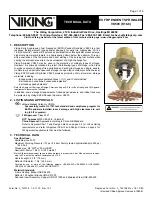
J
USTCHLOR OWNERS HANDBOOK
Page 5 of 16
Created by: Product Management – Just Range of Products – Jasco Trading (Pty) Ltd
After the initial dosing of salt and Stabiliser, top up quantities should only be required when
the pool water is diluted with fresh water. This will only occur after rain, or additions of water
by the pool owner. Test your pool water for salt and Stabiliser (ISO Cyanuric Acid) levels
before adding these two chemicals.
Other chemicals should be added as indicated by pool chemical test. Pool chemical status
should be checked at least once a week during summer months. All chemicals should be
added in small quantities, checking the chemical change after each addition. Following this
procedure saves using excess chemicals and the problems associated with correcting such
errors.
If you suspect
JustChlor
®
chlorinator
is not making chlorine, this can easily be checked:-
•
Whilst the pump is running and the chlorinator is turned on, using your pool test kit,
•
Take a water sample close to the water return nozzle/aimflow.
•
The sample should be taken by placing your thumb over the sample tube, placing the
sample tube in the return stream, and removing your thumb to ensure that you are
testing water coming from the chlorinator.
•
Take a chlorine reading, the reading should be >1.5ppm. If the reading is too high (~
3ppm) adjust the Output Selector Switch down to the next level.
•
Take another chlorine reading the following day, approximately the same time of day,
adjust the Output Selector Switch either up or down to accommodate the new reading
•
Recommended levels should be between 1.0ppm – 3ppm, depending on your pools
specific chlorine demand.
8.
Stabiliser (Cyanuric Acid 40 - 60ppm
)
The chlorine gas produced by the chlorinator needs protection from the ultra violet rays of the
sun. In the absence of Stabiliser, the chlorine produced will be rapidly dissipated into the
atmosphere, giving the impression of zero chlorine reading in the water. Adding the right
amount of stabiliser will enhance the effectiveness of your pool sanitizer.
Stabiliser effectively prolongs the active life of the produced chlorine, allowing sanitization to
take place.
9. pH
The pH is an important part of water chemistry. The effectiveness of the Sanitiser you are
using depends largely on the pH of your swimming pool water. However, the TOTAL
ALKALINTY of your pool plays a large part in how stable the pH will be. It is a known industry
fact that Total Alkalinity keeps the pH from fluctuating high or low; commonly know as
“bounce”. We advise that this be researched on the internet as this is YOUR LEISURE TIME
INVESTMENT?
To maintain the pH of your pool water,
•
Use the standard pool test kit described earlier.
•
Read the instructions on how to perform this test, it is simple and should not be
rushed, rather if need be perform a second test to verify the first tests results.
•
After completing the test follow up with the “Acid demand test”.
•
Referring to the tables supplied with the test kit you will be guided to the
approximate
amount of hydrochloric acid needed to correct the pH of the water.
•
Repeat this test every 24 hours until the desired pH has been reached.
•
Should the pH be too low for the type of pool you have, use “Soda ash” to raise pH
reading in Marbleize pools and “alkalinity increase” in Fiberglass pools?
•
Note: that when filling the pool for the first time and the salt is being added, salt is an
alkaline and will raise the pH level of the water, therefore a fair amount of acid may
be added initially to bring the pH down in the 7,2 – 7,4 window.
TIP:
When adding acid to your pool, it is imperative to dilute the acid in a bucket half filled
with pool water then you pour the diluted mixture into the pool.
10. Water Chemistry Summary




































